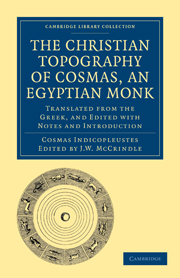 The Christian Topography of Cosmas, an Egyptian Monk
The Christian Topography of Cosmas, an Egyptian Monk APPENDIX
Published online by Cambridge University Press: 10 November 2010
Summary
EXPLANATION OF THE PLATES
Plate 1.—The picture on the left represents the City of Adulê—that on the right an Ethiopian travelling from Adulè to Axômê. The lower picture on the left is the tablet with the Greek inscription copied by Cosmas. It is surmounted by the figure of Ptolemy Euergetês, standing in a warlike attitude. The throne represented on the right is ascribed to the same Ptolemy by Cosmas, but erroneously. It was placed at Adulê by an Axumite conqueror. The writing on the right of it is Δίϕρος Πτολεμοϊκός, Ptolemy's chair.
Plate 2.—The figure of the earth and the heaven, as Cosmas and the ancient Fathers conceived it. The cross-bar represents the firmament.
Plate 3.—A picture of the waters above the firmament.
Plate 4.—A representation of the conical mountain, and also of the sun and the moon under the firmament. The inscription along the pillars is: οἱ στύλοι τοῦ οὐρανοῦ, the pillars of the heaven.
Plate 5.—A tracing of the inhabited world (γῆ οἰκουμένη).
Plate 6.—A representation of the oblong rectangular figure of the earth which we inhabit, with its surrounding ocean, which is itself surrounded by the other earth which was the seat of Paradise and the abode of man before the Flood. The four gulfs which penetrate into our earth from the ocean, and the rivers which flow into it from Paradise, are also depicted.
- Type
- Chapter
- Information
- The Christian Topography of Cosmas, an Egyptian MonkTranslated from the Greek, and Edited with Notes and Introduction, pp. 387 - 392Publisher: Cambridge University PressPrint publication year: 2010First published in: 1897
